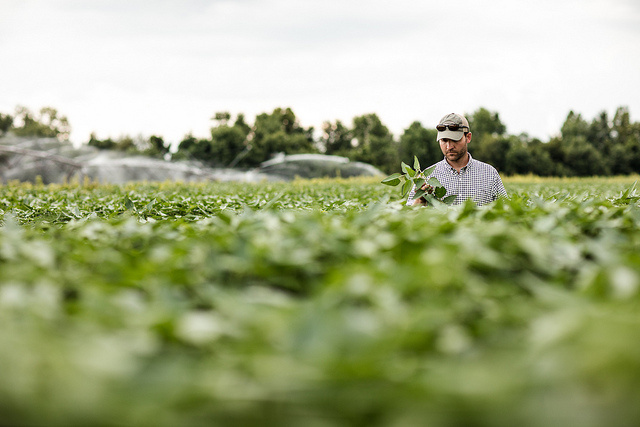Knowledge Exchange Mission: Farmers Eager to Learn from Australian Counterparts

Production systems, weather patterns and even seasons differ, but farmers around the world have many similarities.
Four United Soybean Board farmer-leaders and one university researcher recently traveled down under on a mission with Take Action, a farmer-focused education program designed to help farmers manage herbicide, fungicide and insecticide resistance, funded by the soy checkoff. There, they had the opportunity to learn from Australian growers who have faced similar weed concerns to those seen in the U.S.
The group visited dryland wheat fields in Western Australia, a region considered to be the “herbicide-resistant weed capital of the world,” according to Bob Hartzler, an Iowa State University agronomist.
In the U.S., resistance doesn’t signal an unmanageable environment.
“Weeds may develop resistance to herbicides, but resistance doesn’t necessarily mean weeds are totally uncontrollable,” says Bubba Simmons, a sixth-year USB farmer-leader from Leland, Mississippi. “Farmers are resilient — they will need to explore their options and find practices that work for their farms.”
Finding Common Ground
Farmer-leaders had the opportunity to learn how farmers in Australia are mitigating herbicide resistance.
“In many cases, we visited farmers who still had adequate control of their weeds, even before they introduced new techniques.” Simmons adds, “But, they are looking to the future and taking steps now to ensure they can continue to raise crops and stay in business for years to come.”
Simmons explains that there are certainly similarities in how farmers in both countries produce their respective crops. For example, a great deal of the equipment is similar.
However, there are plenty of other aspects of the operation that are different. For instance, rainfall is drastically different in the two countries. Farms in Western Australia receive a fraction of the precipitation most farms in the U.S. experience.
Both scenarios present opportunities and challenges for growers. The mission considered the differences and looked for lessons that could be tailored for the U.S., particularly about herbicide resistance. Farmers in Australia have been dealing with herbicide-resistant weeds longer than U.S. farmers, and they are further along in the innovation funnel.
“We must take what we saw and learned and further examine how it may be adapted to our production systems,” notes Simmons.
Practices to Protect and Preserve
Farmer-leaders witnessed their Australian counterparts using diverse and creative tools to fight weed resistance. Australian farmers focus on controlling weed seed banks so they stay as low as possible. This includes mechanical methods to catch and destroy the seeds. Australian farmers also work to increase the competitiveness of their crops through experimentation with row spacing and high planting densities along with crop breeding tactics.
Farmers in the U.S. are changing their practices, too, implementing management practices such as crop rotation, varying row spacing, cover crops and managing weeds in waterways.
Herbicides remain one of the most economically efficient methods of controlling weeds, and farmers around the world have a vested interest in preserving these technologies. In addition to cultural management practices, following herbicide application requirements exactly is critical to that preservation.
“We all want to continue farming and stay in business for as long as we want,” adds Simmons. “We know that we won’t be successful if we don’t adapt our practices as our environments change.”
Take Action includes agronomy experts from more than 25 universities located in major row-crop states, seven major herbicide providers, six farmer-led commodity organizations and one industry organization.
Additional resources can be found at: www.IWillTakeAction.org.



